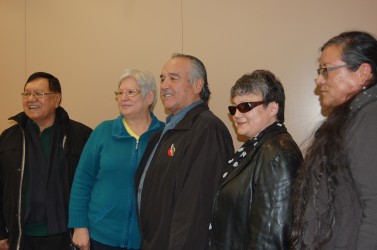Article Origin
Volume
Issue
Year
Photo: Congress of Aboriginal Peoples National Chief Dwight Dorey (centre) with (from left) Ed Lavallee, Marilyn Buffalo, Sandra McKenzie and Sharon Baptiste.
(Photo: Shari Narine)
January 15, 2016
Cree Elder Ed Lavallee is adamant that Aboriginal people moving into urban centres need a voice and he believes that voice can come through the Congress of Aboriginal Peoples.
“As Aboriginal people we have to organize chapters of CAP all across the cities and the country,” Lavallee told a crowded meeting room in downtown Edmonton Thursday night. “We need to do that…. so that our voices can be heard.”
Lavallee said he was confident that, with the new leadership CAP is now under, it is to Alberta’s advantage to create an affiliate chapter.
Dwight Dorey, who was elected National Chief for CAP late last year, vowed to help the province get organized. He says incomplete paperwork last year kept Alberta from becoming one of eight existing CAP affiliates.
“I’m committed to make this happen in a very short time,” he said.
Lavallee’s sentiments were echoed by others in the room.
Papaschase First Nations Chief Calvin Bruneau said he had been working on a proposal to help members of the Papaschase First Nation and realized that the concerns for his members were concerns shared by Aboriginal people living in Edmonton. He said he received little support from the Assembly of Treaty Chiefs or the Metis Settlement General Council. He said urban Aboriginal people did not have a place with either the AOTC or the MSGC.
“We’re at a crossroads here,” he said.
“We have so much work to do,” said former president of the Native Women’s Association of Canada Marilyn Buffalo. “We’re doing this now, but we’re all doing this ourselves, by ourselves.”
“I’m here to change that, Marilyn,” said Dorey.
Numerous concerns were listed by both those who were newcomers to Edmonton and those who had lived in Edmonton for decades.
Among the challenges they face living in an urban centre: affordable housing; access to post-secondary education funding; access to culturally appropriate health care; appropriate funding for prescription drugs; living in isolation and without support in the city; culturally appropriate recreation; access to Indigenous women’s shelters; lack of knowledge about services that are offered; and hassle by the city police.
“We don’t have the structure, so we have no authority,” said Lawrence Willier. “Without structure we’re not going to go nowhere. We’ve got to create that structure.”
Dorey says similar sentiments were voiced in open forums held in Red Deer and Calgary earlier in the week and he is confident a CAP affiliate will soon be operational in Alberta. While the affiliate will be a new organization that will represent the entire province, Dorey says it could consist of representatives from existing organizations.
Dorey’s stop in Alberta is part of his cross-country tour to both create CAP affiliates from every province and territory as well as to get a handle on the “main issues” facing urban Aboriginal peoples. Those issues will be used to create policies and proposals, which CAP will take to the “appropriate jurisdiction,” which could be federal, provincial or municipal governments.
CAP is one of five national Aboriginal representative organizations recognized by the federal government. CAP represents the interests of Métis, off-reserve status and non-status Indians, and Southern Inuit Aboriginal peoples.
- 1911 views

